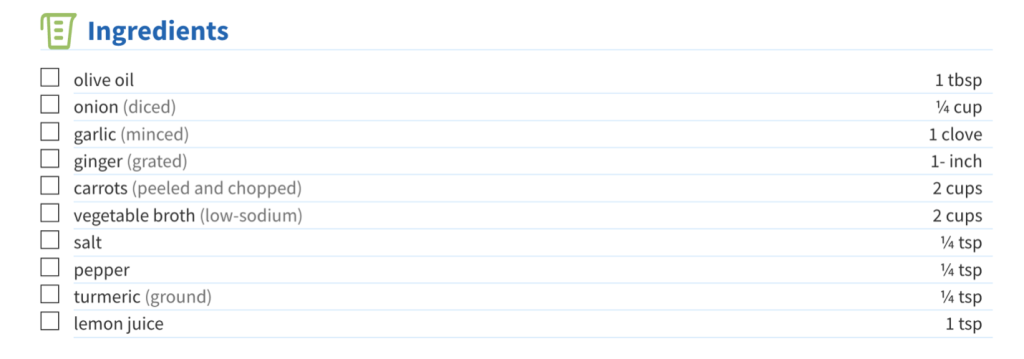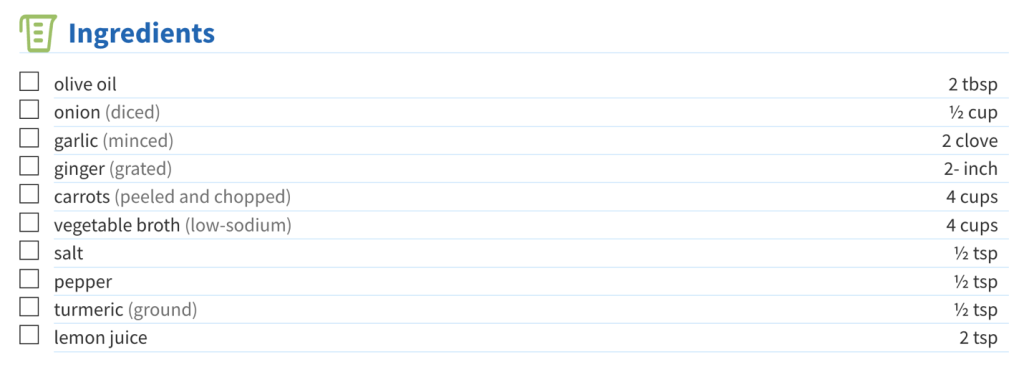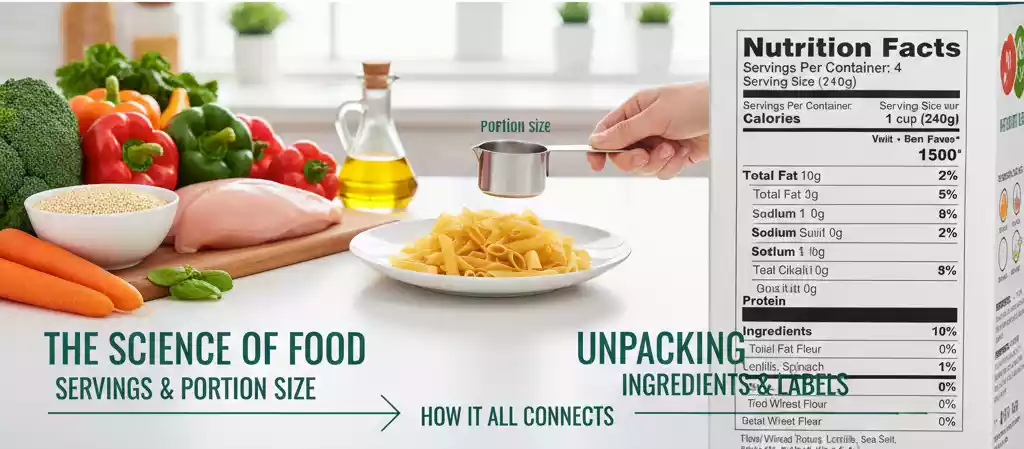What is the difference between serving size and a portion size?
Serving size vs. portion size
A serving size is the amount of food one person is expected to eat at a time and it tells you how the recipe is divided.
- Example: If a recipe makes 4 servings, one serving is ¼ of the total recipe.
Portion size is what you actually eat.
- If you eat more or less than one serving, the nutrients you get will change too.
Let’s look at a real example from our myDCC recipes…
The recipe for One-Pot Easy Pureed Carrot Ginger Soup makes 3 servings.

- If you eat one serving (1 cup), you’re getting 1/3 of the total recipe and the amounts on the nutrition facts table will be correct. The nutrition label shows values per serving, not for the whole pot.
Let’s look at the nutritional values and how they may change based on your portion size. Your actual portion size might not always match the serving size listed. Here is the label based on one portion = 1 cup of soup.

If you serve yourself a larger or smaller amount, the nutrients you consume will change too. Knowing this helps you understand your true intake of carbs and calories.
Tip: Check that the serving size in the recipe matches what people actually eat.
How changing serving size works
Using this same recipe, if you prefer to have a larger portion of this soup, for example 1.5 cups, you will need to calculate the nutrition label based on this larger portion.
Let’s walk through using this same recipe where we change the serving size and see what will happen to the nutritional information.
Easy Pureed Carrot Ginger Soup (makes 3 servings)
Ingredients:

Step A: Check the serving size
Serving size for this recipe is 1 cup soup per person

Step B: Look at the nutrition label
Nutrition amounts are based on 1 serving or 1 cup of soup

If you use 1.5 cups of soup for your serving, you will need to multiply all of the above nutrients by 1.5. In this case, the following nutrients are provided in 1.5 cups of soup:
- Calories: 147.6
- Carbohydrates: 18.75 g
- Fibre: 5.25 g
- Protein: 2.85
Altering the quantity of the whole recipe you make and how it impacts the recipe details
What happens when I change the number of servings for my recipe? For instance, the recipe above for the One-Pot Pureed Carrot Ginger Soup shows that it makes 3 servings, but I want to increase it to 6 servings.
When you change the number of servings in a responsive online recipe, the ingredient amounts automatically adjust to match the new serving size. For example, doubling the servings doubles each ingredient quantity, while halving the servings cuts them in half—ensuring the proportions stay consistent with the original recipe. Let’s look at this recipe when you change the serving size to ‘6 servings’:
If you change the number of servings in your recipe tool to say ‘6 servings’ instead of ‘3 servings’:
- The ingredient amounts scale automatically

- However, the nutrition label does NOT update automatically
- The label will still show 98.4 calories per serving

When you cook at home, knowing the nutrition information in your recipes can help you manage your blood glucose (sugar) and make balanced food choices. Even without a package label, you can still understand what’s in your meal by learning how recipe serving sizes and nutrients work. Each myDCC recipe comes with a nutrition information table to make it easier for you.
What are the key nutrients to focus on for people with diabetes?
Carbohydrates – These affect blood glucose the most. Check both total carbohydrates and fibre. When you are looking at the total carbs that you must consider for a given portion, you can subtract the fibre, since fibre does not affect blood glucose levels (e.g. If total carb amount is 32g and there are 2g fibre; the net amount of carb is 30g). Net amount is the amount that will actually affect your blood sugar.
RECOMMENDED CARB AMOUNTS: 45-60g per main meal, 15-20g per snack
Fibre – Higher-fibre meals can help keep blood sugar steadier.
RECOMMENDED DAILY FIBRE: ≥ 25g/day for women, ≥ 30g/day for men
Protein – Helps you feel full and supports muscle health.
RECOMMENDED DAILY PROTEIN: 0.8g/kg/day (e.g a person weighing 100kg should aim for 80g protein per day)
Fats – Choose unsaturated fats (like olive oil, avocado or nuts) more often than saturated fats (butter, cheese, fatty cuts of meat).
Sodium – Aim to keep it moderate to support heart health.
RECOMMENDED DAILY SODIUM: <2000mg/day
These values can help you balance your plate – especially when pairing meals with snacks or planning for insulin or medication timing.
Understanding nutrition information in recipes helps you take charge of your blood glucose and overall health. By keeping an eye on serving sizes, focusing on carbohydrates and fibre, and estimating your actual portion, you can enjoy home-cooked meals that fit comfortably into your diabetes management plan.



